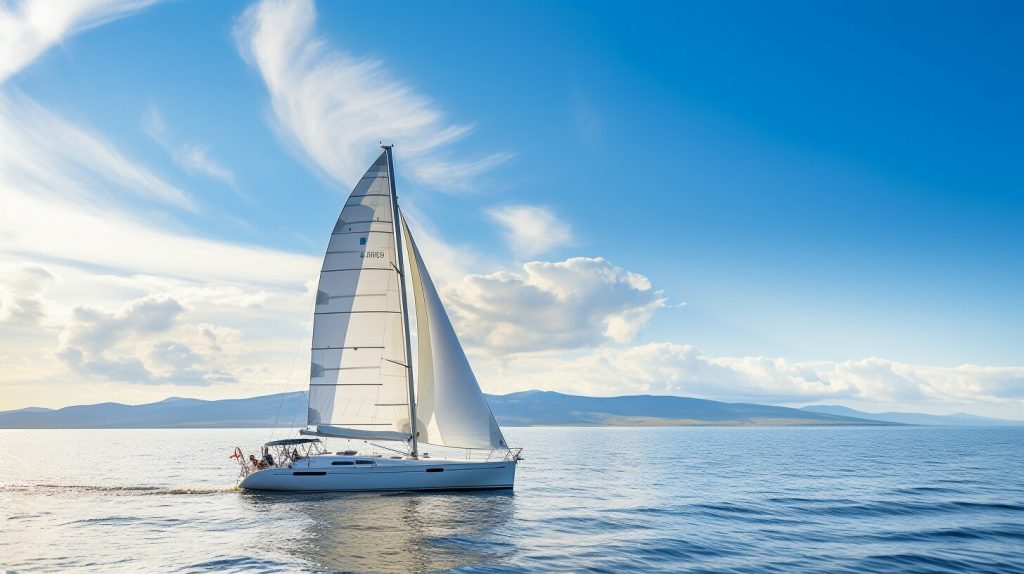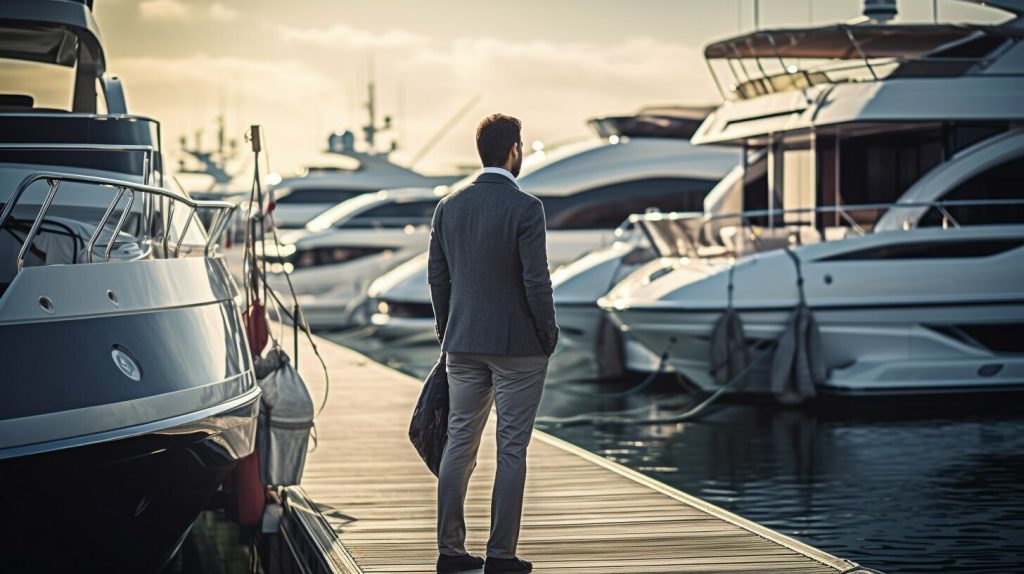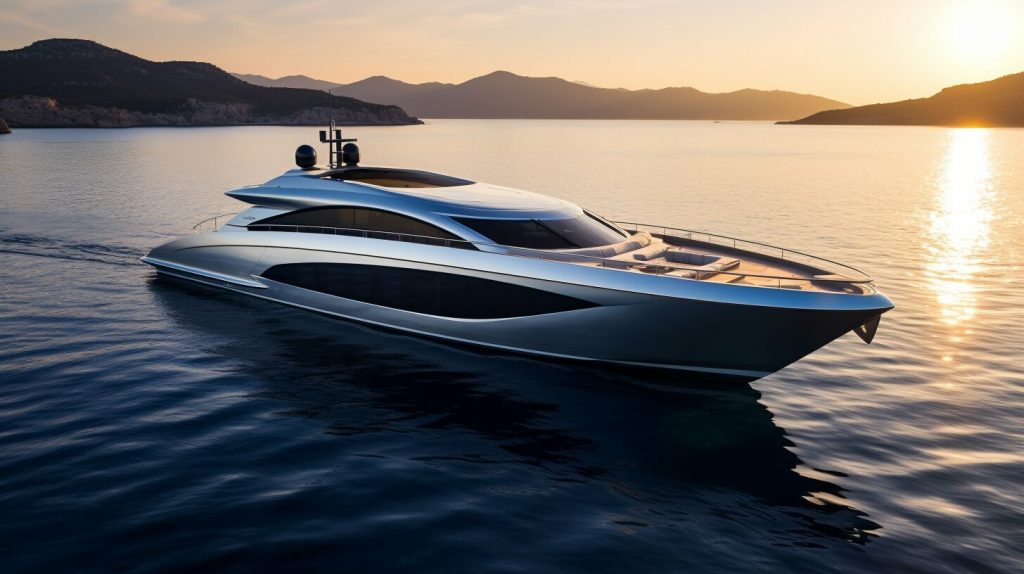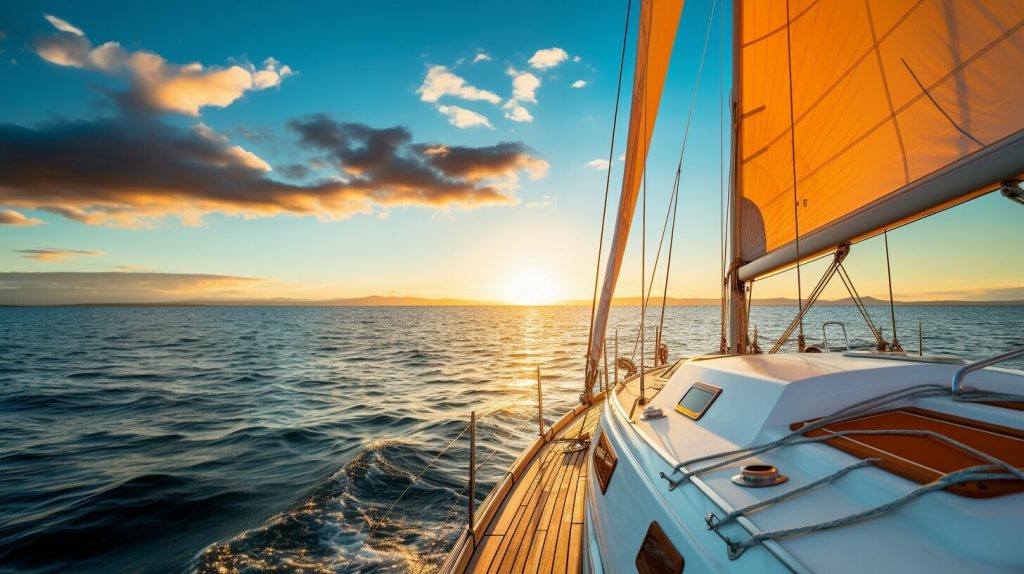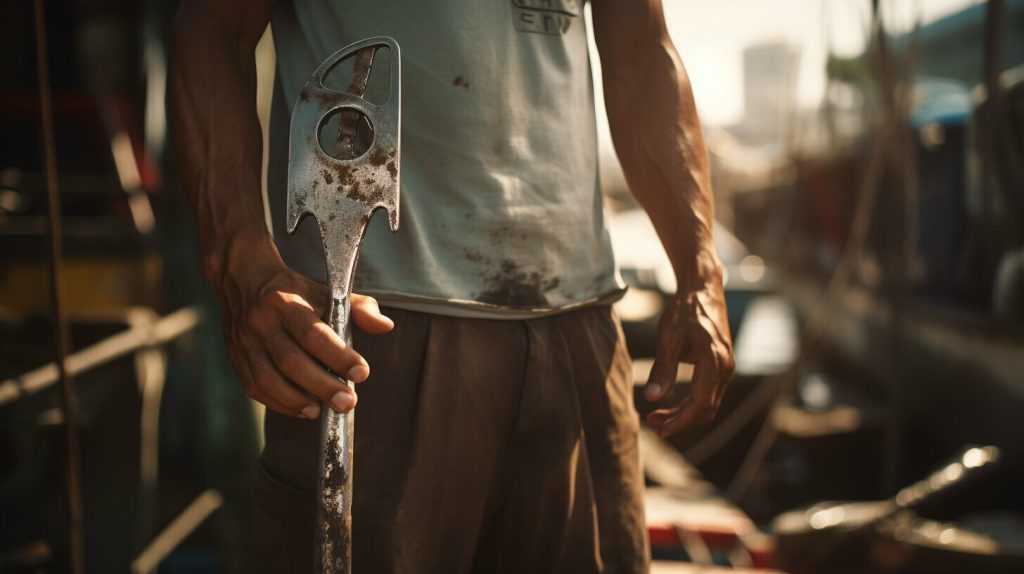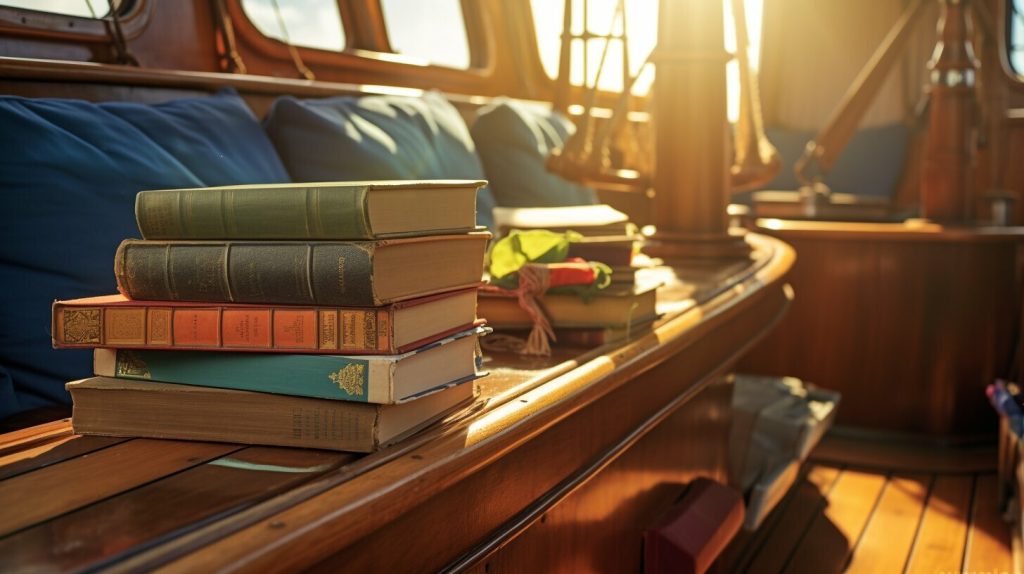If you’re new to sailing and looking to buy a boat? In this article I#ll describe in detail what you need to do in order to find a sailing boat that fits your needs. There are several factors to consider. In this guide, I’ll take you through the essential considerations when choosing a sailing boat, helping you make an informed decision that aligns with your goals and preferences.
Key Takeaways to Find a Sailing Boat:
- Narrow down the type of boat based on your sailing goals and preferences.
- Consider the advantages and disadvantages of different hull materials.
- Understand the role of the keel in ensuring stability and control.
- Know the significance of draft and how it relates to the waterline and hull.
- Look for a sailing boat with a proven yacht design by a renowned designer.
Factors to Consider When Choosing a Sailing Boat
When embarking on the journey of finding your own sailing boat, it’s important to consider various factors that will help you make the right choice. Whether you’re a seasoned sailor or new to the world of sailing, these factors will play a crucial role in determining the perfect boat for your needs.
First and foremost, think about the type of boat that aligns with your sailing goals and preferences. Are you looking for a day cruiser, a racing yacht, or a liveaboard vessel? Each type has its own characteristics that cater to different sailing experiences. Take into account the kind of sailing you enjoy, the number of people you plan to have on board, and the amenities you desire.
The next consideration is the hull material. Sailboats are typically made of fiberglass, wood, aluminum, or steel. Each material has its pros and cons in terms of cost, durability, and maintenance requirements. For example, fiberglass is lightweight and low-maintenance, while wood provides a classic look but requires more upkeep. Evaluate your priorities and choose a hull material that meets your needs.
| Material | Advantages | Disadvantages |
|---|---|---|
| Fiberglass | Lightweight, low-maintenance | Prone to osmotic blistering |
| Wood | Classic aesthetic | Requires regular maintenance |
| Aluminum | Strong and durable | Higher initial cost |
| Steel | Sturdy and resistant to impact | Requires ongoing corrosion protection |
Another important factor is the keel, which plays a significant role in a boat’s stability and control. There are different types of keels, such as fin, full, bilge, and wing. Each type has its own characteristics that influence the boat’s performance. Consider your sailing plans and the waters you’ll be navigating to determine the most suitable keel for your needs.
These are just a few of the factors to consider when choosing a sailing boat. Other aspects include the boat’s draft, yacht design, size, and maintenance costs. By carefully evaluating these factors and considering your own preferences, you’ll be able to find the perfect boat that brings you joy and fulfills your sailing dreams.
Note: The table above provides a comparison of different hull materials for sailing boats. Consider the advantages and disadvantages of each material when making your decision.
Choosing the Right Type of Boat
To find the perfect sailing boat for your needs, it’s important to first determine the type of boat that aligns with your sailing goals and preferences. Whether you’re interested in coastal cruising, bluewater sailing, racing, or simply enjoying day trips on the water, there’s a boat out there that’s perfect for you.
When considering the type of boat, think about the kind of sailing you plan to do. Are you looking for a small and nimble boat that can handle quick day sails? Or perhaps you have dreams of embarking on long ocean passages and need a sturdy, ocean-crossing vessel. Determine your sailing goals, such as the type of waters you want to explore and the distances you plan to cover.
Your personal preferences also play a crucial role in choosing the right type of boat. Some sailors prefer the simplicity and responsiveness of a monohull, while others enjoy the spaciousness and stability of a catamaran. Take into account your comfort level, the number of people you plan to have aboard, and the amenities you desire.
| Type of Boat | Advantages | Disadvantages |
|---|---|---|
| Monohull | Easier to handle in heavy weather | Less interior space |
| Catamaran | Spacious and stable | Higher initial cost |
| Trimaran | Fast and maneuverable | Narrow hulls require more maintenance |
Remember, choosing the right type of boat is a personal decision. Consider your sailing goals and preferences, do your research, and consult with experienced sailors or boat brokers to guide you in making an informed choice.
“When I first started looking for a sailing boat, I wasn’t sure which type would be right for me. But after considering my sailing goals and preferences, I decided that a monohull would be the best fit. Its ability to handle rough conditions and its classic design were exactly what I was looking for. I’m now enjoying every moment on the water, thanks to choosing the right type of boat for me.” – John D., avid sailor
Hull Material and Its Considerations
The hull material plays a crucial role in the performance and maintenance of a sailing boat, so it’s important to understand the options available. Different materials offer distinct advantages and disadvantages, which can greatly impact your sailing experience. Here, I will provide an overview of the most common hull materials and what you need to consider when choosing the right one for your boat.
Fiberglass: Fiberglass is the most popular hull material due to its durability, low maintenance requirements, and affordability. It offers excellent resistance to corrosion, impacts, and osmosis. Fiberglass boats are lightweight, making them easier to handle and maneuver. However, they can be prone to cracking and require regular inspections to detect and repair any potential issues.
Wood: Wooden hulls have a timeless charm and are favored by sailing enthusiasts for their aesthetic appeal. They provide excellent insulation, making them ideal for colder climates. However, wooden boats require regular maintenance, including varnishing and caulking, to prevent rot and water damage. They can be more expensive to repair and may require skilled craftsmen for restoration work.
Aluminum: Aluminum hulls are known for their strength, durability, and resistance to corrosion. They are lightweight, providing improved speed and fuel efficiency. Aluminum boats require less maintenance compared to wooden hulls and are less prone to damage from grounding or impacts. However, they can be more expensive to purchase and repair.
| Hull Material | Advantages | Disadvantages |
|---|---|---|
| Fiberglass | Durable, low maintenance, affordable | Potential for cracking, regular inspections required |
| Wood | Timeless charm, good insulation | Requires regular maintenance, expensive repairs |
| Aluminum | Strength, durability, corrosion resistance | Higher initial cost, more expensive repairs |
When selecting a hull material for your sailing boat, consider factors such as your budget, intended usage, and personal preferences. Each material offers unique characteristics and requires varying levels of maintenance, so it’s essential to choose one that aligns with your needs and expectations. By understanding the advantages and disadvantages of different hull materials, you can make an informed decision and embark on your sailing adventures with confidence.
Understanding the Role of the Keel
The keel is an important component of a sailing boat, as it greatly affects the way the boat handles in the water. It provides stability and control, helping to keep the boat upright and on course. There are different types of keels, each with its own advantages and considerations.
One common type is the fin keel, which is a long, slender protrusion attached to the bottom of the boat’s hull. It provides excellent stability, allowing the boat to resist tipping over and maintain a straight course. However, fin keels have a deep draft, meaning they require deeper waters to navigate comfortably.
Another type is the wing keel, which features two shorter fins on either side of the boat’s hull. This design offers improved maneuverability, making it easier to navigate in shallower waters. However, wing keels may sacrifice some stability compared to fin keels.
Ultimately, the choice of keel depends on your sailing goals and the conditions you plan to sail in. If you prioritize stability and plan to venture into deeper waters, a fin keel may be the better option. On the other hand, if you anticipate sailing in shallower areas and value maneuverability, a wing keel might be more suitable. Consider consulting with a knowledgeable boat dealer or experienced sailor to help you make the right decision.
| Keel Type | Advantages | Considerations |
|---|---|---|
| Fin Keel | Excellent stability, straight course | Requires deeper waters |
| Wing Keel | Improved maneuverability | May sacrifice some stability |
Understanding the role of the keel is essential when choosing a sailing boat. It impacts how the boat performs in the water, affecting stability and control. By considering your sailing goals and preferences, as well as the conditions you plan to navigate, you can select the right keel type for your needs. Whether you prioritize stability or maneuverability, there is a keel design that can enhance your sailing experience and provide you with the control you desire.
Decoding Draft: What You Need to Know
The draft of a sailing boat is a crucial measurement that determines how much of the boat’s hull is submerged in the water. It is measured as the vertical distance between the waterline and the bottom of the hull. Understanding the concept of draft is essential when choosing a sailing boat, as it directly affects the boat’s performance, stability, and maneuverability.
When considering the draft of a sailing boat, it’s important to take into account the water conditions you will be sailing in. A boat with a shallow draft is ideal for cruising in shallow waters, such as coastal areas or lakes, where the water depth may be limited. On the other hand, a boat with a deeper draft is more suitable for offshore sailing, as it provides better stability in rough seas.
It’s also worth noting that the draft of a sailing boat is closely related to its hull design. Different hull shapes and configurations can affect the draft, as well as the boat’s overall performance. For example, a boat with a fin keel typically has a deeper draft compared to a boat with a shoal keel. A deeper draft allows for better upwind performance and reduces leeway, but it may limit access to shallower areas.
When considering the draft of a sailing boat, it’s important to strike a balance between performance and practicality. Assess your sailing goals and the waters you plan to navigate, and consult with experienced sailors or boat professionals who can guide you in finding the right draft for your needs.
| Draft | Waterline | Hull |
|---|---|---|
| Measurement that determines how much of the boat’s hull is submerged in the water | Horizontal line marking the boat’s water level | Structure of the boat’s body beneath the waterline |
| Affects a boat’s performance, stability, and maneuverability | Varies based on factors such as load, weight distribution, and sea conditions | Can be influenced by hull shape, keel type, and boat design |
| Shallow draft is ideal for cruising in shallow waters | Deeper draft provides better stability in rough seas | Balance between performance and practicality is crucial |
In summary, the draft of a sailing boat plays a significant role in its performance and suitability for different sailing conditions. Consider the depth of the waters you’ll be navigating, as well as the boat’s hull design, when choosing the right draft. By finding the optimal balance between performance and practicality, you can enhance your sailing experience and enjoy the freedom of exploring the open seas.
Optimal Yacht Design by Renowned Designers
When searching for a sailing boat, it’s wise to consider designs created by renowned yacht designers, as they often provide superior performance and comfort. These designers have honed their craft over years of experience, resulting in boats that excel in both form and function.
Renowned yacht designers bring their expertise and creativity to the table, producing vessels that are not only aesthetically pleasing but also optimized for smooth sailing. With a deep understanding of naval architecture and engineering principles, they create yachts that are agile, stable, and efficient.
One notable example is the award-winning yacht designer, John Peterson. Known for his innovative designs, Peterson has a reputation for pushing the boundaries of boat design. His attention to detail and commitment to quality ensure that each yacht he crafts is a masterpiece.
I believe that a well-designed sailing boat should embody the perfect harmony between performance and comfort. Every curve, every line should serve a purpose, enhancing the sailing experience for both the captain and the crew.
Another renowned designer is Emily Turner, whose designs focus on creating a luxurious and enjoyable onboard experience. With a keen eye for style and functionality, Turner’s yachts are known for their spacious interiors, state-of-the-art amenities, and exquisite finishes.
Incorporating Innovation and Quality
Renowned yacht designers continuously push the boundaries of innovation, incorporating cutting-edge technologies and materials into their designs. They work closely with naval engineers, ensuring that every aspect of the boat is meticulously engineered for optimal performance and safety.
Additionally, renowned designers often collaborate with skilled craftsmen and artisans to bring their visions to life. From the finest woodwork to the most intricate metalwork, these designers prioritize quality in every detail.
When choosing a sailing boat, consider the works of renowned yacht designers. Their expertise, passion, and dedication to their craft can make a significant difference in your sailing experience. Whether you’re seeking a boat for racing, cruising, or both, opting for a design by a renowned designer ensures that you are investing in a vessel that is built to exceed your expectations.
| Advantages of Optimal Yacht Design | Disadvantages of Optimal Yacht Design |
|---|---|
| Superior performance on the water | Higher price tag |
| Enhanced stability and control | Longer production times |
| Improved onboard comfort and amenities | Customization options may be limited |
Finding the Right Size for Your Budget and Comfort
Finding the perfect size for your sailing boat involves considering your budget, the number of people who will be on board, and the level of comfort you’re looking for. Boat size plays a crucial role in both the enjoyment and practicality of your sailing experience. To help you make an informed decision, here are some key points to keep in mind.
1. Budget:
When determining the size of your boat, it’s important to consider your budget. Smaller boats generally come with lower purchase prices, reduced maintenance costs, and lower mooring fees. They also tend to be more fuel-efficient. On the other hand, larger boats offer more amenities and space but can be more expensive to purchase and maintain.
2. Number of People:
Think about how many people will be regularly aboard your sailing boat. If you plan to sail with just a partner or a small group of friends, a smaller boat may be suitable. However, if you have a larger family or frequently entertain guests, a larger boat with multiple cabins and living areas may be necessary to ensure everyone’s comfort.
3. Level of Comfort:
Consider your desired level of comfort while onboard. Smaller boats may have limited space for amenities such as kitchens, bathrooms, and sleeping quarters. If you prioritize comfort and plan to spend extended periods aboard your boat, a larger vessel with more spacious accommodations will provide a better experience.
By carefully considering your budget, the number of people on board, and your desired level of comfort, you can find the perfect size for your sailing boat. Remember, it’s important to strike a balance between functionality, cost, and enjoyment to make the most of your sailing adventures
When it comes to sailing, size does matter. Whether you’re a beginner or an experienced sailor, choosing the right size boat is essential for your safety, enjoyment, and overall experience on the water. So, take the time to evaluate your budget, consider the number of people who will be joining you on your adventures, and determine the level of comfort you desire. Once you have a clear understanding of your needs, you’ll be better equipped to find the perfect size boat that meets your requirements and allows you to fully embrace the joy of sailing life.
Understanding Maintenance Costs
Owning a sailing boat involves various maintenance costs, so it’s important to understand the financial implications before making a decision. These costs can vary depending on factors such as the size and age of the boat, as well as the type of equipment and amenities it has. Here are some key expenses to consider:
- Insurance: Boat insurance is essential for protecting your investment and covering potential accidents, damage, or theft. Premiums can vary based on factors such as the boat’s value, location, and usage.
- Mooring and Storage: Depending on where you live and sail, you may need to pay for mooring or docking fees at a marina or yacht club. If you plan to store your boat during the off-season, you’ll also need to budget for storage fees.
- Maintenance and Repairs: Regular maintenance tasks such as cleaning, painting, and engine servicing will incur costs. Additionally, unexpected repairs may arise, especially with older boats or those that have been subjected to harsh conditions.
- Upgrades and Equipment: As you gain experience and spend more time on your boat, you may want to add or upgrade equipment such as navigational systems, sails, or safety gear. These expenses can significantly impact your budget.
To get a better understanding of the maintenance costs, it’s advisable to consult with experienced boat owners, join online boating forums, or seek advice from professionals at yacht clubs or marinas. They can provide insights into typical costs associated with boat ownership and share tips on how to budget effectively.
Remember, proper maintenance and care for your boat are essential not only for its longevity but also for your safety and enjoyment on the water. By budgeting for maintenance costs and staying on top of regular upkeep, you can ensure that your sailing experience remains smooth, hassle-free, and enjoyable.
Table: Typical Maintenance Costs for Sailing Boats
| Expense | Annual Cost Estimate |
|---|---|
| Insurance | $1,000 – $5,000 |
| Mooring and Storage | $1,000 – $5,000 |
| Maintenance and Repairs | $1,500 – $10,000+ |
| Upgrades and Equipment | $1,000 – $5,000+ |
Please note that the costs provided in the table are estimates and can vary depending on the size, condition, and location of the boat, as well as individual preferences and needs.
While understanding and budgeting for maintenance costs is crucial, it’s also important to remember the joy and fulfillment that come with owning a sailing boat. By being prepared and informed about the financial commitments, you can embark on your sailing adventure with confidence, knowing that you have accounted for the necessary expenses and can fully enjoy the experience of being out on the water.
Recommended Books for Liveaboards
To enhance your sailing experience and gain valuable knowledge, there are several books that are highly recommended for liveaboards. These books cover a wide range of topics, from cruising guides to boat maintenance, and provide invaluable insights for those embarking on the sailing lifestyle. Here are some must-reads:
- “The Complete Sailor” by David Seidman: This comprehensive guide covers the essentials of sailing, from tying knots to reading charts. It’s an excellent resource for beginners and experienced sailors alike, offering practical advice and tips.
- “The Cruising Guide to the Caribbean” by Chris Doyle: If you’re planning to sail the Caribbean, this guide is a must-have. It provides detailed information on anchorages, marinas, and local customs, helping you navigate the beautiful islands with ease.
- “Boatowner’s Mechanical and Electrical Manual” by Nigel Calder: This essential reference book covers everything you need to know about maintaining and troubleshooting the mechanical and electrical systems on your boat. It’s a valuable resource for DIY boat owners.
Another highly recommended book is “The Essential Galley Companion” by Amanda Swan Neal: This informative guide offers practical tips on provisioning, meal planning, and cooking aboard a sailboat. It’s a great resource for those looking to make the most of their onboard culinary experiences.
Table: Recommended Books for Liveaboards
| Book Title | Author | Topic |
|---|---|---|
| The Complete Sailor | David Seidman | Sailing essentials |
| The Cruising Guide to the Caribbean | Chris Doyle | Caribbean sailing |
| Boatowner’s Mechanical and Electrical Manual | Nigel Calder | Boat maintenance |
| The Essential Galley Companion | Amanda Swan Neal | Onboard cooking |
“Sailing a boat calls for quick action, a blending of feeling with the wind and water as well as with the very heart and soul of the boat itself.” – George Matthew Adams
These recommended books for liveaboards will enrich your knowledge and help you make the most of your sailing adventures. Whether you’re a novice sailor or an experienced liveaboard, these resources will provide valuable insights and inspiration as you navigate the vast seas and embrace the sailing lifestyle.
Embracing the Joy of Sailing Life
Sailing is not just a hobby or a means of transportation; it is a way of life that brings immense joy and fulfillment to those who embrace it. The feeling of being out on the open water, harnessing the power of the wind, and navigating through nature’s elements is an experience like no other. Whether you’re sailing solo, with a partner, or surrounded by friends and family, the sense of freedom and adventure is truly intoxicating.
One of the greatest joys of the sailing lifestyle is the opportunity to explore new destinations and discover hidden gems. From picturesque coastal towns to secluded islands, the world becomes your oyster as you sail from one breathtaking location to another. The sense of discovery and the ability to create your own itinerary is what sets sailing apart from any other form of travel.
But it’s not just the destinations that make sailing so special. It’s the sense of community and camaraderie that comes with being part of the sailing world. From sharing stories and tips with fellow sailors at the marina to joining regattas and races, there is a deep connection that forms among sailors. The sailing community is a supportive and tight-knit group, always ready to lend a helping hand or offer advice to those who are new to the lifestyle.
| Advantages of the Sailing Lifestyle | Disadvantages of the Sailing Lifestyle |
|---|---|
|
|
“Twenty years from now, you will be more disappointed by the things you didn’t do than by the ones you did do. So throw off the bowlines. Sail away from the safe harbor. Catch the trade winds in your sails. Explore. Dream. Discover.” – Mark Twain
If you’re considering embracing the sailing lifestyle, I encourage you to take the leap and dive into this incredible adventure. Whether you choose to live aboard your boat full-time or simply embark on weekend getaways, the joy and fulfillment that await you are unparalleled. So set sail, explore the world, and let the wind carry you to new horizons. Your sailing journey awaits!
Congratulations on completing your guide to finding a sailing boat! Now that you have explored the essential factors to consider, it’s time to embark on your sailing adventure and find the perfect boat for you.
As a beginner, narrowing down the type of boat you’re looking for is crucial. Consider your sailing goals and preferences. Do you envision yourself cruising along the coast or embarking on adventurous offshore voyages? Knowing this will help you choose a boat that aligns with your aspirations.
When assessing different sailing boats, pay attention to the hull material. Each material, whether fiberglass, wood, or aluminum, has its own advantages and disadvantages. Understanding these nuances will ensure you select a boat that suits your needs and preferences.
Stability and control are vital aspects of sailing, and the keel plays a significant role in achieving them. Familiarize yourself with the keel’s influence on your sailing experience to make an informed decision when choosing a boat.
The draft, which is the distance between the waterline and the bottom of the hull, is another consideration. Different sailing conditions may require varying draft depths. Understanding the concept of draft and how it relates to the waterline and hull will help you find a boat that performs optimally in your desired sailing environment.
Opting for a yacht design created by renowned designers offers an added level of reassurance in terms of performance and functionality. Look for boats with proven designs crafted by well-known designers to enhance your sailing experience.
When determining the size of your boat, consider your budget, the number of people who will be on board, and the level of comfort and space you desire. Finding the right balance between these factors will ensure that you are satisfied with your investment.
It’s essential to be aware of the maintenance costs associated with owning a sailing boat. Choose a boat size that aligns with your budget and allows you to enjoy the sailing lifestyle without unnecessary financial strain.
Lastly, we recommend delving into the wealth of knowledge available in books for liveaboards. These resources cover a range of topics, from cruising guides to boat maintenance, sailing knowledge, and even onboard cooking. By immersing yourself in these books, you’ll gain valuable insights and valuable tips to navigate the sailing lifestyle with confidence.
With your guide complete and armed with this newfound knowledge, it’s time to set sail on your sailing boat adventure. May the wind be at your back and the open sea fill your heart with joy and wonder. Happy sailing!
FAQ
Q: What factors should I consider when choosing a sailing boat?
A: When choosing a sailing boat, consider factors such as the type of boat, hull material, keel, draft, yacht design, size, and maintenance costs.
Q: How do I narrow down the type of boat I’m looking for?
A: Narrow down the type of boat based on your sailing goals and preferences.
Q: What are the advantages and disadvantages of different hull materials?
A: Different hull materials have various advantages and disadvantages. It is important to understand these factors when choosing a sailing boat.
Q: What is the role of the keel in a sailing boat?
A: The keel plays a significant role in providing stability and control to a sailing boat.
Q: What is draft and why is it important?
A: Draft refers to the distance between the waterline and the bottom of the hull. Understanding draft is essential as it relates to the boat’s maneuverability and the waters it can navigate.
Q: How important is yacht design when choosing a sailing boat?
A: Choosing a sailing boat with a proven yacht design by a well-known designer can ensure better performance and overall satisfaction.
Q: How do I determine the right size of a sailing boat?
A: Consider your budget, the number of people aboard, and your desired level of comfort and space when determining the right size of a sailing boat.
Q: What are the maintenance costs associated with owning a sailing boat?
A: Owning a sailing boat comes with maintenance costs. It is crucial to understand these costs and choose a boat size that fits within your budget.
Q: Are there any recommended books for liveaboards?
A: Yes, there are several recommended books for liveaboards that cover topics such as cruising guides, boat maintenance, sailing knowledge, and onboard cooking. These books can provide valuable information and guidance.

